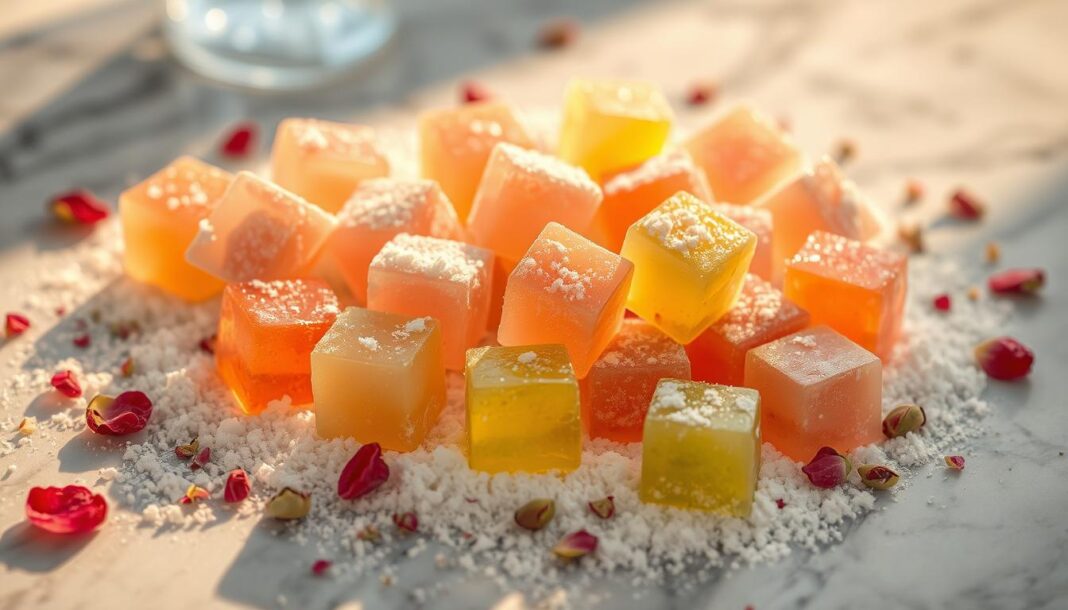In C.S. Lewis’s timeless classic, “The Lion, the Witch and the Wardrobe,” the White Witch tempts Edmund Pevensie with a magical confection known as Turkish Delight. This enchanted candy has captivated readers’ imaginations since the book’s publication, leaving many to wonder about its origins and taste.
We delve into the world of the Chronicles of Narnia to explore the significance of this famous treat. With a rich history dating back centuries in the Middle East, Turkish Delight has become an integral part of the narrative, symbolizing temptation and the struggle between good and evil.
In this article, we will uncover the history and literary significance of Turkish Delight and provide a detailed recipe to recreate this tempting treat in your own kitchen, bringing a taste of Narnia to your home.
The Enchanting Power of Turkish Delight in Narnia
In the world of Narnia, Turkish delight is more than just a sweet treat; it’s a tool of temptation and a symbol of the White Witch’s power. C.S. Lewis, the mastermind behind “The Lion, the Witch and the Wardrobe,” ingeniously uses this confection to weave a complex narrative that explores themes of temptation, betrayal, and the fleeting nature of pleasure.
Edmund’s Temptation by the White Witch
The White Witch’s offer of Turkish delight to Edmund Pevensie is a pivotal moment in the story, marking the beginning of Edmund’s downfall. The Witch uses the treat to lure Edmund into her trap, promising him “Turkish Delight, finer than any I’ve ever tasted” and “all the Turkish Delight you could ever want” if he brings her his siblings. This moment highlights the seductive power of temptation and how it can lead individuals astray.
We can see the impact of this temptation in the way Edmund betrays his family, illustrating the destructive potential of giving in to fleeting pleasures. The high sugar content of Turkish delight creates a momentary pleasure that quickly fades, mirroring the temporary satisfaction of succumbing to temptation.
The Symbolic Meaning in C.S. Lewis’s Work
C.S. Lewis, a master of Christian allegory, employs Turkish delight as a multifaceted symbol representing sin, temptation, and the transitory nature of worldly pleasures. The exotic and luxurious nature of Turkish delight also symbolizes the otherworldliness of Narnia, a land that seems too good to be true and exists outside the normal experience.
| Symbolic Element | Representation in Narnia | Significance |
|---|---|---|
| Turkish Delight | Temptation and Sin | Represents Edmund’s betrayal and the fleeting nature of pleasure |
| Sugar Content | Momentary Pleasure | Mirrors the temporary satisfaction of giving in to temptation |
| Exotic Nature | Otherworldliness of Narnia | Symbolizes a land that seems too good to be true |
For more insights into the historical context and recipe of Turkish delight, visit our article on the Chronicles of Narnia Turkish Delight. This exploration into the enchanting power of Turkish delight in Narnia not only deepens our understanding of C.S. Lewis’s work but also highlights the enduring allure of this confectionery treat.

The Real History of Turkish Delight
Turkish Delight, known for its delicate flavors and gelatinous texture, has a storied past that begins in the heart of Turkey. This beloved candy has been a staple in Turkish culture for centuries, captivating the taste buds of people around the world.
Origins in Turkey: The Story of Lokum
The origins of Turkish Delight, also known as Lokum, date back to the 18th century in Turkey. It is believed that this sweet treat was first created in the Ottoman Empire, where it quickly gained popularity among the nobility. The original recipe involved a gel made from starch and sugar, flavored with rosewater or other essences. For more on how Turkish Delight is featured in literature, you can visit our page on Turkish Delight in Narnia.

Traditional Flavors and Variations
Classic Turkish Delight is renowned for its delicate floral flavors, with rose being the most traditional and recognizable variety. However, authentic Turkish Delight comes in numerous variations, including lemon, orange blossom, mint, and pomegranate. Many traditional recipes incorporate chopped nuts such as pistachios, hazelnuts, or walnuts, adding texture and richness to the sweets. The sugar content in Turkish Delight is balanced with fruit essences and sometimes honey, creating a complex flavor profile. Gift boxes of assorted Turkish Delight remain popular souvenirs from Turkey, typically featuring a selection of different flavors and colors arranged in an ornate presentation.
- Classic Turkish delight features delicate floral flavors, with rose being the most traditional and recognizable variety.
- Beyond the rose-flavored version, authentic Turkish delight comes in numerous variations including lemon, orange blossom, mint, and pomegranate.
- Many traditional recipes incorporate chopped nuts such as pistachios, hazelnuts, or walnuts, adding texture and richness to the candy.
Making Narnia Edmund Turkish Delight at Home
To recreate the enchanting Turkish Delight from ‘The Lion, the Witch, and the, start by understanding the basics of this traditional confectionery. Making Turkish Delight, just like the White Witch used to tempt Edmund, is a fun and rewarding process for any home cook. It’s a matter of mastering a few key techniques and using the right ingredients.
Essential Ingredients and Equipment
Before you begin, it’s crucial to have all your ingredients and equipment ready. The essential ingredients include granulated sugar, cornstarch, water, and flavorings such as rose water or lemon juice. You’ll also need a medium saucepan, a candy thermometer, and a 9×13 inch baking dish. Having the right tools and ingredients is a matter of attention to detail, ensuring that your Turkish Delight turns out perfectly.
| Ingredient | Quantity |
|---|---|
| Granulated Sugar | 2 cups |
| Cornstarch | 1 cup + 2 tablespoons |
| Water | 4 cups |
Preparing the Sugar Syrup
Preparing the sugar syrup is a critical step in making Turkish Delight. Combine the sugar and water in a saucepan, and place it over medium heat, stirring until the sugar dissolves. Bring the mixture to a boil, then reduce the heat to medium-low and simmer until it reaches 300°F on a candy thermometer. This process requires patience and attention to time, as the syrup needs to reach the correct temperature to set properly.
Creating the Perfect Cornstarch Slurry
While the syrup is doing its thing, let’s talk slurry. In a jar, combine the cornstarch and water. Seal it up and shake like you’re doing a workout challenge. The goal is a cloudy, well-mixed concoction. If it settles, just give it another good shake before using. The key to a perfect slurry is ensuring there are absolutely no lumps, and we’re happy to share this technique because it makes a significant difference in achieving that perfect gel-like consistency.
- The cornstarch slurry is what gives Turkish delight its distinctive texture, and getting it right is a matter of proper proportions and mixing technique.
- We recommend combining 1 cup plus 2 tablespoons of cornstarch with approximately 4 cups of cold water to create the ideal slurry consistency.
- Timing matters when preparing your slurry—it should be ready to go when your sugar syrup reaches temperature, so prepare it while the syrup is cooking.
- An important note: the slurry will naturally settle if left standing, so be prepared to give it one final shake just before adding it to your hot sugar syrup.
By following these steps and paying attention to the details, you’ll be able to create a delicious Narnia-inspired Turkish Delight that’s sure to impress. It’s a recipe worth sharing, and with practice, you’ll get better at it, making it a delightful treat to share with friends and family.
Step-by-Step Turkish Delight Recipe
Now that we’ve explored the history and significance of Turkish Delight in Narnia, it’s time to dive into the recipe. Making Narnia-inspired Turkish Delight at home is a delightful experience that combines tradition with fantasy. We will guide you through the process, ensuring that you achieve the perfect texture and flavor.
Combining and Cooking the Mixture
The first step in making Turkish Delight is to combine the sugar, water, and cream of tartar in a saucepan. We heat this mixture to a boil, then reduce the heat to a simmer. In a separate bowl, we mix the cornstarch and water to create a smooth slurry. Gradually adding the cornstarch slurry to the saucepan, we continue to cook until the mixture thickens. This process requires patience and constant stirring to prevent lumps from forming. Properly cooking the mixture is crucial for achieving the right consistency.
Adding Flavors and Colors
Once the mixture has thickened, we add flavorings and colors to create the signature taste and appearance of Turkish Delight. Traditional flavors include rosewater and lemon, while colors can range from subtle pastels to vibrant hues. Experimenting with different flavors and colors allows you to personalize your Turkish Delight. For a Narnia-inspired version, consider using flavors and colors that evoke the enchanting world created by C.S. Lewis.
Setting, Cutting, and Coating
After adding the desired flavors and colors, we pour the mixture into a greased surface, allowing it to set. Once set, the Turkish Delight is cut into small cubes. To prevent sticking, we coat the pieces in a mixture of powdered sugar and cornstarch. This coating not only adds sweetness but also helps maintain the texture. For storage, we recommend keeping the pieces in an airtight container, buried in the powdered sugar/cornstarch mixture, much like burying treasure in a protective box of sweetness.
Storage and Serving Tips
Proper storage is key to maintaining the quality of Turkish Delight. We recommend storing the pieces in an airtight container filled with a 2:1 ratio of powdered sugar to cornstarch. It’s best to consume the Turkish Delight within 72 hours, as it is at its peak freshness during this time. Many would like to know if Turkish Delight can be frozen; while technically possible, we don’t recommend it as the texture suffers upon thawing. When serving, mention that this treat has been enjoyed for centuries and gained fame in Western countries after being featured in C.S. Lewis’s beloved article. One common question is whether it should be chilled; however, Turkish Delight is best enjoyed at room temperature.
- Store Turkish Delight in an airtight container with a generous amount of powdered sugar/cornstarch mixture.
- Consume within 72 hours for optimal freshness.
- Avoid freezing to preserve texture.
- Serve at room temperature for the best experience.
Over the years, we’ve found that Turkish Delight makes an impressive gift when packaged in a decorative box. A bit of food history to share when serving adds to the delight of enjoying this centuries-old treat.
Conclusion: Bringing a Taste of Narnia to Your Home
Our exploration of Turkish Delight has taken us from the enchanting land of Narnia to the kitchens of Turkey, and now, to your own kitchen. Making Turkish Delights at home is a journey that combines patience with the joy of crafting something special from scratch.
We’ve journeyed through history, symbolism, and preparation, connecting us to both literary history and centuries-old food traditions. This magical confection brings a bit of wonder to our everyday lives. While the recipe requires precision, the reward is a truly authentic taste experience.
Whether you’re preparing it for a Narnia-themed gathering or as a gift, homemade Turkish Delight offers a unique connection to culinary history and beloved literature. For any remaining questions, remember that Turkish Delight making is as much art as science—perfection comes with practice. So, grab a piece, close your eyes, and let the taste whisk you away to a snow-covered land where anything is possible.


